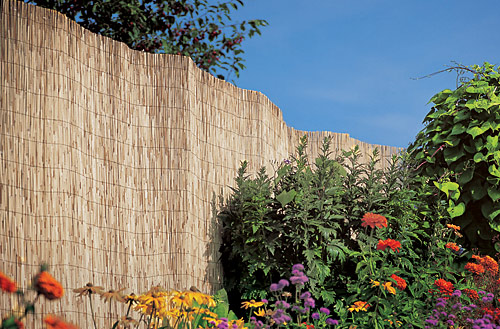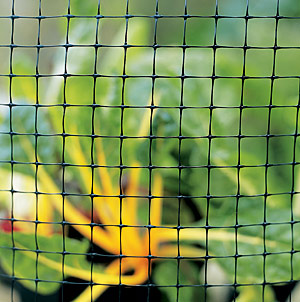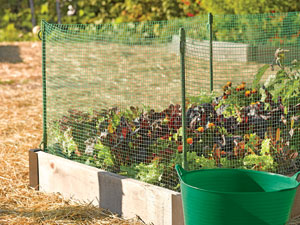






Solid fences, such as this Reed Fence, ensure that animals can't see what they're missing.

Deer Fences can be lightweight, yet effective.

The Low Pest Fence prevents pesky rabbits, woodchucks and other small animals—including pets—from raiding and romping in your garden.
Fencing is the only sure-fire way to keep wild and domestic animals out of a prized garden. Although it can be expensive to keep out large animals, such as deer, it may be the only way to protect your yard from costly damage. Here are some points to keep in mind:
Deer
Deer are probably tops on the list of many homeowners. Because deer can jump, the fence needs to be constructed high and at an angle to deter them. There are many design variations for deer barriers available from game wardens. One effective option is an 8- to 10-foot-tall fence slanted at a 45 degree angle in the direction deer are most likely to come. It will make them think twice about jumping. Keep the fence snug to the ground, because deer can also wiggle under fences.
Electric fences baited with peanut butter and solid fences that block the view to a food source also work well.
Cats and Dogs
Build a wire mesh fence 3-feet high anchored with sturdy posts. Cats probably won't climb over, and most dogs can't knock it over. Bend the base of the fence outward to form a 2-foot wide apron along the ground to discourage dogs from digging under it. More on cats and dogs.
Rabbit
Exclude rabbits with a 2-foot-tall chicken wire fence that has 1-inch diameter holes. To prevent them from digging under, curve the bottom of the fence 90 degrees to create an apron a foot or so wide, and bury it several inches deep.
Woodchuck
Like raccoons and opossums, woodchucks are good climbers, so any fence will have to be unattached at the top 18 inches or have electric wire strung across the top to discourage these pests. The 4-foot tall fence should also have a 2-foot wide apron buried a few inches below the soil to stop them from burrowing under the fence. Electric fence placed a few inches outside a wire fence also helps.
Tunneling Pests: Gophers, Chipmunks, Moles, etc.
These subterranean travelers have the advantage of being out of sight most of the time, and can do their dirty work of munching your plants undetected. In winter, they move beneath the snow and gnaw the bark off young tree trunks, and you often don’t discover the damage until spring. If your garden is plagued by any of these tunneling creatures, you can create cages or baskets to protect prized plants. Dig a 2- to 3-foot deep hole in the planting area and line the sides and bottom of the bed with wire mesh. Replace the soil and plant your garden.
Protect tree trunks with wire mesh guards placed a few inches below the soil line and 2 feet up the trunk. Check the guards in the spring and fall, adjusting them to make room for tree growth and to be sure they are securely fastened. More on gophers, chipmunks and moles.
Raccoon and Opossum
These animals dig and climb, so this fence needs a floppy top and a barrier to digging. A 4-foot fence with the top 18 inches unattached will fall back on the climbing creature, keeping it from scaling the fence. To prevent them from tunneling under, curve the bottom of the fence 90 degrees to create a 2-foot wide apron, and bury it several inches deep. Placing and electric wire on top of a 3- to 4- foot-tall fence will also work.
Raccoons and opossums don't like material that clings to their feet, so draping bird netting on the ground outside of the fence and keeping the grass mowed may also deter them. More on raccoons and opossums.
Coyote
Start with a perimeter electric fence. Add a sheep fence with another electric fence wire strung 8" off the ground and a few inches in front of the sheep fence. Because coyotes can jump, add an electric wire on top of the sheep fence as well.
Bear
Bears can easily maul most fences, but they can be discouraged from entering an area they haven't explored yet. Since they don't like walking over chicken wire, lay a 3- to 4-foot wide swath of it on the ground and secure it well. Keep the area mowed. Electric fencing is effective if bears encounter the hot fence before they know about the food source on the other side.
Copyright © www.100flowers.win Botanic Garden All Rights Reserved